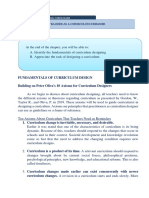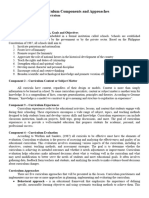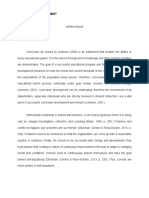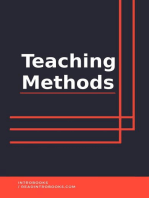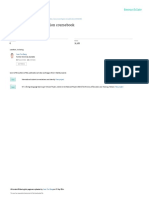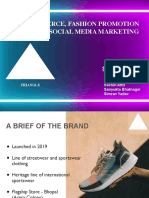0 ratings0% found this document useful (0 votes)
145 viewsCurriculum Development: Module 7: Fundamental of Curriculum Designing
Curriculum Development: Module 7: Fundamental of Curriculum Designing
Uploaded by
Mark Angelo De GraciaThis document discusses the fundamental components of curriculum design. It identifies the major components as: intended learning outcomes, subject matter/content, teaching and learning methods, and assessment/evaluation. For each component, guidelines are provided. Intended learning outcomes should be specific, measurable, attainable, results-oriented and time-bound. Content should be relevant to the outcomes and appropriate for the learners' level. Teaching methods can include various approaches like cooperative learning, independent learning, and competitive activities. Assessment should provide formative and summative feedback to support learning. These core components apply to designing lessons, courses or full curriculum and ensure a systematic process is followed.
Copyright:
© All Rights Reserved
Available Formats
Download as PPTX, PDF, TXT or read online from Scribd
Curriculum Development: Module 7: Fundamental of Curriculum Designing
Curriculum Development: Module 7: Fundamental of Curriculum Designing
Uploaded by
Mark Angelo De Gracia0 ratings0% found this document useful (0 votes)
145 views22 pagesThis document discusses the fundamental components of curriculum design. It identifies the major components as: intended learning outcomes, subject matter/content, teaching and learning methods, and assessment/evaluation. For each component, guidelines are provided. Intended learning outcomes should be specific, measurable, attainable, results-oriented and time-bound. Content should be relevant to the outcomes and appropriate for the learners' level. Teaching methods can include various approaches like cooperative learning, independent learning, and competitive activities. Assessment should provide formative and summative feedback to support learning. These core components apply to designing lessons, courses or full curriculum and ensure a systematic process is followed.
Original Description:
MODULE 7: FUNDAMENTAL OF CURRICULUM DESIGNING
Original Title
Curriculum Development
Copyright
© © All Rights Reserved
Available Formats
PPTX, PDF, TXT or read online from Scribd
Share this document
Did you find this document useful?
Is this content inappropriate?
This document discusses the fundamental components of curriculum design. It identifies the major components as: intended learning outcomes, subject matter/content, teaching and learning methods, and assessment/evaluation. For each component, guidelines are provided. Intended learning outcomes should be specific, measurable, attainable, results-oriented and time-bound. Content should be relevant to the outcomes and appropriate for the learners' level. Teaching methods can include various approaches like cooperative learning, independent learning, and competitive activities. Assessment should provide formative and summative feedback to support learning. These core components apply to designing lessons, courses or full curriculum and ensure a systematic process is followed.
Copyright:
© All Rights Reserved
Available Formats
Download as PPTX, PDF, TXT or read online from Scribd
Download as pptx, pdf, or txt
0 ratings0% found this document useful (0 votes)
145 views22 pagesCurriculum Development: Module 7: Fundamental of Curriculum Designing
Curriculum Development: Module 7: Fundamental of Curriculum Designing
Uploaded by
Mark Angelo De GraciaThis document discusses the fundamental components of curriculum design. It identifies the major components as: intended learning outcomes, subject matter/content, teaching and learning methods, and assessment/evaluation. For each component, guidelines are provided. Intended learning outcomes should be specific, measurable, attainable, results-oriented and time-bound. Content should be relevant to the outcomes and appropriate for the learners' level. Teaching methods can include various approaches like cooperative learning, independent learning, and competitive activities. Assessment should provide formative and summative feedback to support learning. These core components apply to designing lessons, courses or full curriculum and ensure a systematic process is followed.
Copyright:
© All Rights Reserved
Available Formats
Download as PPTX, PDF, TXT or read online from Scribd
Download as pptx, pdf, or txt
You are on page 1of 22
CURRICULUM DEVELOPMENT
MODULE 7: FUNDAMENTAL OF CURRICULUM
DESIGNING
FUNDAMENTAL OF CURRICULUM DESIGNING
• A curriculum as a planned sequence of learning
experiences should be at the heart and mind of every
teacher. Every teacher as a curricularist should be
involved in designing a curriculum. As such, you will be a
part of the intellectual journey of your learners. You will be
providing them with the neccessary experiences that will
enable the learner what you intend them learn. Designing
a curriculum is a very challenging task. It is here where
the style and creativity of the teacher come in.
Every curriculum designer, implementer, or evaliator should
take in mind the following axioms as a guide in curriculum
development.
1. Curriculum change is inevitable, necessary, and
desirable.
2. Curriculum is a product of its time.
3. Curriculum changes made can exist concurrently with
newer curriculum change.
4. Curriculum change depends on people who will
implementthe change.
5. Curriculum development is a cooperative group activity.
6. Curriculum development is a decision-making
processmade from choices of alternatives.
7. Curriculum development is an on-going process.
8. Curriculum development is more effective if it is a
comprehensive process, rather than “piecemeal”.
9. Curriculum development is more effective when itfollows
a systematic process.
10. Curriculum starts from where the curriculum is.
Let us continue learning how to design a curriculum by
identifying its components. The major components of most
curricula answer the following question:
1. What learning outcomes need to be achieved? (Intended
Learning Outcome)
2. What content should be included to achieve the learning
outcomes? (Subject Matter)
3. What learning experiences & resources should be
employed? (T-L methods)
4. How will the achieved learning outcomes be measured.
(Assessment of Achieved Learning Outcomes)
ELEMENTS OR COMPONENTS OF CURRICUUM
DESIGN
There are many labels or names for curriculum design.
Some would call it a syllabus, or a lesson plan. Some all it a
unit plan or course design. Whatever is the name of the
design, the common components for all them are almost the
same.
Let us take the Lesson Plan as a minisculecurriculum. A
lesson plan or teaching guide includes (1) Intended
Learning Outcomes (ILO) or the Desired Learning
Outcomes (DSO).
formerly labeled as behavioral objectives, (20 SUBJECT
Matter or Content), (3) Teaching and Learning Methods,
and (4) Assessment Evaluation. Each of these components
or element is described below:
1. Behavioral Objectives or Intended Leraning Outcomes
-The objectives or intended outcomes are the reasons for
unertaking the learning lesson from the student’s point of
view; it is desired learning outcome that is to be
accomplished in a particular learning episode, engaged in
by the learners uner the guidance of the teacher.
As a curriculum designer, the beggining of the learning journey
is the learning outcomes to be achieved. In this way both the
learner and the teacher are guided by what to accomplish.
The Behavioral objectives, intended learning outcomes are
expressed in acton words found in the revised Bloom’s
Taxonomy of Objectives for the development of cognitive skills.
The statement should be SMART; Specificn Measurable,
Attainable, Result oriented and Time bound. For example, if a
lesson intends the students to identify the parts of a simple
flower as stated in the desired learning outcomes, then students
should have identified that parts of a simple flower, at the end of
the lesson.
Sometimes the phrase intended learning outcomes is used
to refer to the anticipate results after completing the
planned activity or lesson. In framing learning outcomes:
• Express its outcome in terms of what successful students
will be able to do. For example, rather than stating
students will be able to explain the reason why...”this
helps the students to focus on what they have to achieve
as learning. It will also curricularist devise assessment
tasks.
• Include different kinds of outcomes. The most common
are cognitive objectives (learning facts, the theories,
formulae, principles, etc.) and performance outcomes
(learning how to carry out procedures, calculations,
calculations, and processes, which typically include
gathering information and communicating results). In
some contexts, affective outcomes are important too (for
develoving attitudes or values , e.g. those require as a
person and for a particular profession.
II. Content/Subject Matter
-The content of the lesson or unit is the topic or subject
matter that will be covered.
In selecting content, you should bear in mind the following
principles.
• Subject matter should be relevant to the outcomes of the
curriculum. An effective curriculum is purposive and
clearly focused on the planned learning outcomes.
Subject matters should be appropriate to the level of the
lesson or unit. An effective curriculum is purposive,
leading students towards building of previous lessons.
• Contents which are too basic or too advanced for the
development levels of learners make students either
bored or baffled, and affect their motivation to learn.
Subject matter should be up to date and, if possible,
should reflect current concepts.
• III. References
The reference follows the content. It tells where the content
or subject matter has been taken. The references may be a
book, a module, or any application, or any publication. It
must bear the author of the material, and the publication.
Examples are:
1. Project Wild (1992) Kto 12 Activity Guide. An
Interdisciplinary, Supplementary Conservation and
Environmental Education Program Council of
Environmental Education, Bethesda, MD.
2. Shipman James and Jerry Wilson, et. al. (2009). An
Introduction to physical Science Houghton Miffin Co.
Boston. MA
3. Romo, Salvador B. (2013) Horticulture an Exploratory
Course. Lorimar Inc. Quezon City
IV. Teaching and Learning Methods
These are the activities where the learners derive experiences. It is
always good to keep in mind the teaching strategies that students
will experiences (lectures, laboratory, classes, fieldwork, etc. ) and
make them learn. The teaching-learning methods should allow allow
cooperation, competion as well as individualism or independent
learning among the students. For example:
1. Cooperative learning activities allow students to work together,
Students are guided to learn on their own to find solution to their
problems. The role of the teacher to guide the learners. Democratic
process is encouraged and each one contributes to the success of
learning. Students learn from each other in ways. Giving project and
activities considerably enhance the curriculum.
2. Independent learning activities allow learners to develop personal
responsibility. The degree independence to learn how to learn is
enhanced. The strategy is more appropriate for fast learners.
3. Competitive activities where student will test their competencies
against another in a healthy manner allow learners to perform to
their maximum. Most succesful individuals in their adult life are
competitive even in early schooling. They mostly become the
survivors in a very competitive work.
4. The use of various delivery modes to provide learning
experiences is recommended online learning and similar modes are
increasingly important in many curricula but these need to be
planned carefully to be effective.
V. Assessment Evaluation
Learning occurs most effectively when students receive feedback.
The process by which this information is generated is assessment. It
has three functions:
1. Self assessment, through which students learn to monitor and
evaluate their own learning. This should be a significant element in
the curriculum because we aim to produce graduates who are
appropriately reflective and self-critical.
2. Peer assessment in which student provide feedback on each
other’s learning. This can be viewed as an extension of self
assessment and presupposes trust and mutual respect.
3. Teacher assessment in which the teacher prepares and
administers tests and gives feedback on the student’s performance.
Assessment may be formative or summative. Many
assessment tasks involved an element of both, e.g. an
assignment that is returned to the students wd comments.
Summative assessment usually involves the allocation of
marks or grades. This helps the teacher makes decision
about the progress or performance of the students.
Student usually learn more by understanding the strengths
and weaknesses of their work by knowing the marks or
grades given to it. For this reason, summative assessment
tasks should include an element of formative feedback, if
possible.
Application of the Fundamental Components to other Curriculum
Designs
While our example refers only to designing a lesson plan which is a
mini curriculum, similar components will also be used in making a
syllabus for teaching in higher education courses or other curricular
projects. Based on the curriculum models we have learned, the
fundamental components include the following: Major components
of a Course Design or Syllabus:
1. Intended Learning Outcomes (or objectives)
2. Content/Subject Matter (with references)
3. Methods/Strategies (with needed resources)
4. Evaluation (means of assessment)
• All other additional components are trimming that each
designer may place. This additional part may be an
institutional template, suggested by other curriculum
experts and as required by educational agencies like the
Department of Education, Commission on HIger
Education, Accrediting Agencies, professional
Organizations that would serve the purpose they intent to
achieve.
You might also like
- How To Win Friends and Influence PeopleDocument6 pagesHow To Win Friends and Influence PeopleNaison StanleyNo ratings yet
- 64 Interview Questions 1Document57 pages64 Interview Questions 1Oscar Bosha100% (6)
- Going To Hospital - Teacher's PackDocument41 pagesGoing To Hospital - Teacher's PackGuilherme PuppimNo ratings yet
- Detailed Lesson Plan in English KinderDocument3 pagesDetailed Lesson Plan in English KinderThereseJeanSargentoStaAna83% (35)
- Curriculum (Education)Document4 pagesCurriculum (Education)joshua humirang80% (5)
- Chapter 2 Module 3Document14 pagesChapter 2 Module 3sofeia delambacaNo ratings yet
- Module 3 Lesson 1Document6 pagesModule 3 Lesson 1Edlord Moster100% (1)
- Lesson 1. Curriculum DesignDocument6 pagesLesson 1. Curriculum DesignRose Ann San PascualNo ratings yet
- Designing The Curriculum: Fundamentals of Curriclum DesignDocument11 pagesDesigning The Curriculum: Fundamentals of Curriclum Designjater100% (1)
- The Teacher As A Curriculum Designer: Maripert S. de Guzman Bsed-EnglishDocument55 pagesThe Teacher As A Curriculum Designer: Maripert S. de Guzman Bsed-EnglishElaine VelascoNo ratings yet
- CHAPTER 2 - Designing The CurriculumDocument9 pagesCHAPTER 2 - Designing The CurriculumLiza Maramag100% (2)
- EDUC 8 PrefinalDocument27 pagesEDUC 8 PrefinalMarjorie Lanante MendozaNo ratings yet
- EDTSCU 2024 Chapter 2 Module 3 For StudentsDocument13 pagesEDTSCU 2024 Chapter 2 Module 3 For StudentsEla Mae SilmaroNo ratings yet
- Module 3Document29 pagesModule 3Vince Darwin M. GabonaNo ratings yet
- Crafting The CurriculumDocument21 pagesCrafting The CurriculumLovely LouiseNo ratings yet
- Fundamentals of Curriculum DesignDocument19 pagesFundamentals of Curriculum DesignNemalyn Arizala BasasNo ratings yet
- Curriculum Notes - Module 4Document10 pagesCurriculum Notes - Module 4Dayang DayangNo ratings yet
- Ma'Am Sunshine 12 To 1Document14 pagesMa'Am Sunshine 12 To 1kimberlygarfilNo ratings yet
- Module 3Document9 pagesModule 3CHERRY MAE ALVARICONo ratings yet
- Crafting The CurriculumDocument32 pagesCrafting The CurriculumkhejimboyNo ratings yet
- MODULE 2 Crafting The CurriculumDocument31 pagesMODULE 2 Crafting The CurriculumClauditte SaladoNo ratings yet
- Educ 8 Reporting Sir AbesarDocument32 pagesEduc 8 Reporting Sir AbesarMary Joy Salazar SalazarNo ratings yet
- Unit 3 Phases and Processes of Curriculum DevelopmentDocument4 pagesUnit 3 Phases and Processes of Curriculum DevelopmentDara Rose FilosofoNo ratings yet
- Module 3Document9 pagesModule 3Jessa Mae RoneNo ratings yet
- Curriculum and The TeacherDocument34 pagesCurriculum and The TeacherMia Geron LabradorNo ratings yet
- TT&SC Chapter2 M3.1Document9 pagesTT&SC Chapter2 M3.1Patricia GeroyNo ratings yet
- Lesson 1 Fundamentals of Curriculum DesigningDocument51 pagesLesson 1 Fundamentals of Curriculum Designingmarcocadunggan08No ratings yet
- Curriculum DesignDocument32 pagesCurriculum DesignLorena Cabradilla0% (1)
- of Curriculum DevelopmentDocument32 pagesof Curriculum DevelopmentAntoniete Gonto100% (6)
- Educ 6 Curriculum Designing - 035853Document26 pagesEduc 6 Curriculum Designing - 035853Salvador Delos SantosNo ratings yet
- CD Assignment NewDocument6 pagesCD Assignment NewumaizatawheedNo ratings yet
- Module 3 Curriculum Development 2 PDFDocument14 pagesModule 3 Curriculum Development 2 PDFManuel CruzNo ratings yet
- EDCK 4 - Chapter 2Document27 pagesEDCK 4 - Chapter 2Rolando EdquidNo ratings yet
- Chapter 2 Module Crafting The CurriculumDocument23 pagesChapter 2 Module Crafting The CurriculumPrincess Twinkle Joyce MaguddayaoNo ratings yet
- EDUC 105 Midterm ReviewerDocument41 pagesEDUC 105 Midterm ReviewerDaquis, Demie Beatrice C.No ratings yet
- Prof Ed 4 MidtermDocument6 pagesProf Ed 4 MidtermsophiavalladoresNo ratings yet
- TeachCur MidtermDocument9 pagesTeachCur Midtermellagenie.lagusNo ratings yet
- ED 301 Module 2Document12 pagesED 301 Module 2Ethel Sorio LigonesNo ratings yet
- Module 23Document9 pagesModule 23Kel LumawanNo ratings yet
- Group 3 Report Educ 302Document6 pagesGroup 3 Report Educ 302Etad NeNo ratings yet
- CHAPTER 2 ProfEd 9 (Estrada&Pun-An)Document111 pagesCHAPTER 2 ProfEd 9 (Estrada&Pun-An)Jane sidon estradaNo ratings yet
- POLON - Asynchronous Task No. 3 (Advanced Curriculum Planning, Evaluation and Development)Document11 pagesPOLON - Asynchronous Task No. 3 (Advanced Curriculum Planning, Evaluation and Development)Pey PolonNo ratings yet
- Principles of PlanningDocument18 pagesPrinciples of Planningsanjanapinto23No ratings yet
- Elements of CurriculumDocument27 pagesElements of CurriculumAli imtiazNo ratings yet
- Introduction: Assessment and EvaluationDocument11 pagesIntroduction: Assessment and EvaluationPrarthana KakotyNo ratings yet
- ModuleDocument22 pagesModuleRenave MaeNo ratings yet
- Chapter 2Document60 pagesChapter 2Albert CaruruanNo ratings yet
- Curriculum DevelopmentDocument14 pagesCurriculum DevelopmentIrwan M. IskoberNo ratings yet
- Group 2 Key PointersDocument6 pagesGroup 2 Key PointersDarlene EsmeraldaNo ratings yet
- COMPONENT 3 - Curriculum ExperiencesDocument15 pagesCOMPONENT 3 - Curriculum ExperiencesJayCesar67% (3)
- ReviewerDocument6 pagesReviewerGuiang, Maezynelle P.No ratings yet
- Lesson 5: Curriculum Development: Processes and ModelsDocument11 pagesLesson 5: Curriculum Development: Processes and ModelsAngel Keith GicaNo ratings yet
- CHAPTER 1 Lesson 2cDocument3 pagesCHAPTER 1 Lesson 2cHeheNo ratings yet
- Information She-Wps OfficeDocument9 pagesInformation She-Wps OfficeQUIJANO, FLORI-AN P.No ratings yet
- Component 3 - Curriculum ExperiencesDocument3 pagesComponent 3 - Curriculum ExperiencesAna HakuraNo ratings yet
- Ped 7. ReviewerDocument7 pagesPed 7. ReviewerJOANA BELEN CA�ETE JABONETANo ratings yet
- DocumentDocument3 pagesDocumentImee C. CardonaNo ratings yet
- Outline ReportDocument4 pagesOutline Reportroesajanisselagare73No ratings yet
- Branggan, Razel L. - EDUC 128 WRITTEN REPORTDocument7 pagesBranggan, Razel L. - EDUC 128 WRITTEN REPORTbrangganrazel2002No ratings yet
- Guide For The Selection and Use of Methods:: PROF ED 217 Group 1Document7 pagesGuide For The Selection and Use of Methods:: PROF ED 217 Group 1Jovelinda BandaoNo ratings yet
- Curriculum DevelopmentDocument61 pagesCurriculum DevelopmentRocky RabinoNo ratings yet
- Curriculum DevelopmentDocument21 pagesCurriculum Developmentglenn flor100% (1)
- Curiculum DevelopmentDocument5 pagesCuriculum Developmentdaily liveNo ratings yet
- Daily Lesson Plan in Understanding Culture, Society and PoliticsDocument4 pagesDaily Lesson Plan in Understanding Culture, Society and PoliticsRed AgbonNo ratings yet
- Speed Reading Group 2Document14 pagesSpeed Reading Group 2Vasya HarradillahNo ratings yet
- Products and Services & BrandsDocument48 pagesProducts and Services & BrandsX XNo ratings yet
- Sf1 - 2021 - Grade 10 (Year IV) - EinsteinDocument6 pagesSf1 - 2021 - Grade 10 (Year IV) - EinsteinFernadez RodisonNo ratings yet
- Fall 2021 - MCM304 - 1Document3 pagesFall 2021 - MCM304 - 1AlmasNo ratings yet
- LESSON-PLAN-IN-ENGLISH 6 Week 8Document2 pagesLESSON-PLAN-IN-ENGLISH 6 Week 8CAREN-JOY BARNIEGONo ratings yet
- What Is Local SEO?: Presented By: Tyler HorvathDocument14 pagesWhat Is Local SEO?: Presented By: Tyler HorvathOmere FaruqNo ratings yet
- Listening Sample Worksheet ASLDocument3 pagesListening Sample Worksheet ASLGagan Nd100% (2)
- Introduction To Error Control CodingDocument32 pagesIntroduction To Error Control Codingwangshu421No ratings yet
- DLL 6 ResearchDocument4 pagesDLL 6 ResearchMary DignosNo ratings yet
- Syed Abbas Raza ZaidiDocument2 pagesSyed Abbas Raza ZaidiAbbas RazaNo ratings yet
- URBAN DESIGN - Rejuvenating The Space - Mayuresh Desai - ArchinectDocument6 pagesURBAN DESIGN - Rejuvenating The Space - Mayuresh Desai - ArchinectliuelNo ratings yet
- W1-2 Rhetorical SituationsDocument38 pagesW1-2 Rhetorical SituationsAbohfu Venant ZinkengNo ratings yet
- Cooperative EFLDocument11 pagesCooperative EFLmarcela beltranNo ratings yet
- Cause and Effect LessonDocument12 pagesCause and Effect Lessonapi-380123137100% (1)
- ANSWER KEY To ActivityDocument2 pagesANSWER KEY To ActivityNoelli Mae BacolNo ratings yet
- 05 CC Professional Email Writing SEM 3Document6 pages05 CC Professional Email Writing SEM 3Vamshi ValasaNo ratings yet
- Professionalism and Ethics Self-Management - Year RoundDocument1 pageProfessionalism and Ethics Self-Management - Year RoundBoredpandaNo ratings yet
- Kolehiyo NG Lungsod NG Lipa: Marawoy, Lipa City Tel. No: (043) 706-0434Document2 pagesKolehiyo NG Lungsod NG Lipa: Marawoy, Lipa City Tel. No: (043) 706-0434AldrinBalitaNo ratings yet
- Interpreting and Translation Coursebook: January 1999Document43 pagesInterpreting and Translation Coursebook: January 1999ckrpNo ratings yet
- Brand Launch With Media & Website PlanDocument25 pagesBrand Launch With Media & Website PlanSachin AttriNo ratings yet
- Jenny Gieselman ResumeDocument2 pagesJenny Gieselman Resumeapi-351315379No ratings yet
- Reviewer in Reading and WritingDocument5 pagesReviewer in Reading and WritingHannah IsagaNo ratings yet
- Annie JohnDocument10 pagesAnnie Johnapi-246271718No ratings yet
- Lesson Exemplar Programming 12 Quarter 4 Week 3 and 4Document4 pagesLesson Exemplar Programming 12 Quarter 4 Week 3 and 4AileenD.EnriquezNo ratings yet
- HUAWEI E353 HSPA+ USB Stick Product EnglishDocument19 pagesHUAWEI E353 HSPA+ USB Stick Product EnglishRead SethNo ratings yet


















